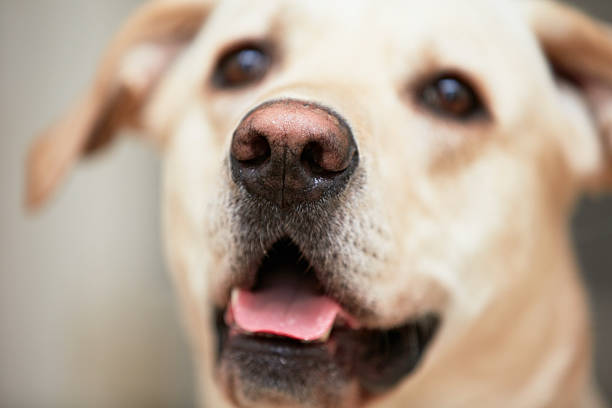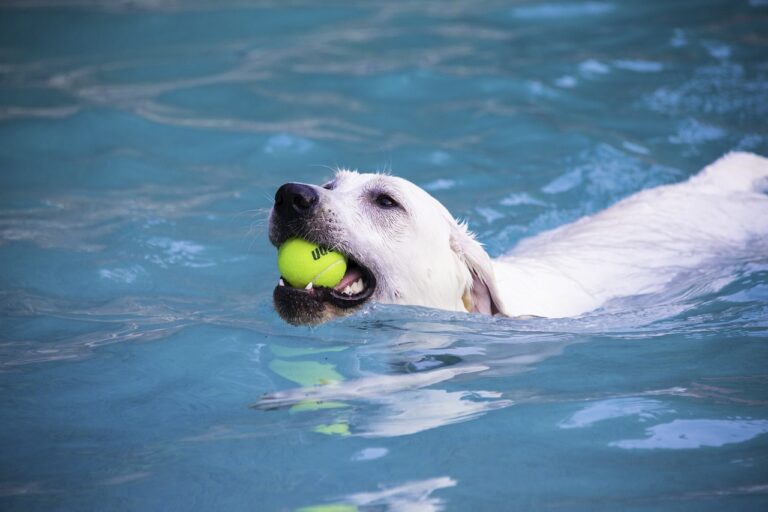What Is A British Labrador?
If you’re a dog lover or have been hunting for your next furry companion, you may have heard about British Labradors or English Labs. These breeds of Labrador retrievers have been gaining popularity in the United States, and for a good reason. Today, we’re diving into what is a British Labrador and why it matters.
So first things first, what exactly is a British Labrador? In simple terms, they are a Labrador retriever breed originating from the United Kingdom. Of course, they share many of the same traits as the American Labrador, but a few key differences set them apart. Some experts argue that British Labs are more “traditional” than their American counterparts, with a heavier build, shorter legs, and thicker, otter-like tails.
This article aims to help you understand what makes a British Labrador unique and why you might consider one as your next pet. From temperament to physical characteristics, we’ll go through everything you need to know about these lovable pups. So if you’ve been curious about the difference between British and American Labradors or you’re trying to decide which type is right for you, keep reading!
Characteristics of British Labradors
If you’ve ever been around British Labrador Retrievers, you know how friendly and lovable they can be. But have you ever wondered what makes a British Labrador different from the rest? Here are some of the physical and temperamental characteristics that make British Labradors unique.
Physique
Well, let me tell you about the physique of British Labs. These pooches are quite the lookers, with a height ranging from 21.5 to 22.5 inches and a weight that usually falls between 60 to 80 pounds. Now, that may not mean a whole lot to you if you’re not used to thinking about dog measurements, but trust me – these guys have a nice, solid build that gives them a strong and athletic appearance.
And then there’s their coat color. Oh boy, do these dogs have an array of options! Whether you’re drawn to a classic yellow, a rich chocolate brown, or a sleek black coat, there’s a British Lab out there for you. And what’s cool is that their coats can vary in the shade quite a bit – some yellows can look almost white, while others have a much deeper pigment.
But what about their coat type, you may ask? Well, British Labs have a shorter, denser coat that typically sheds seasonally. It’s not overly prone to matting or tangling, which makes grooming relatively easy – but, of course, the shedding means you’ll still need to break out the vacuum from time to time. Overall, it’s a lovely coat that adds to the breed’s rugged charm.
Temperament
These dogs are known for being incredibly intelligent, trainable, and affectionate companions. They have a strong desire to please their owners, which makes them excellent candidates for obedience training and other activities that require discipline and focus.
When it comes to trainability, British Labradors excel in a variety of fields. Their intelligence and eagerness to learn to mean that they pick up new commands quickly and their friendly disposition makes them easy to work with. They thrive on positive reinforcement, meaning praise, treats, and other rewards are often more effective than punishment or scolding.
In terms of personality, British Labradors are known for their social, outgoing nature. They make friends easily, both with humans and other animals, and are just as happy hanging out with their families as they are meeting new people at the dog park. They are often described as gentle and patient, making them great for families with children.
One of the most interesting things about British Labradors is that they often have a strong work ethic. This is largely due to their history as hunting dogs; many still have a strong desire to retrieve objects and complete tasks. This means that they enjoy activities like fetch, hiking, and agility training and need plenty of exercises to stay happy and healthy.
Health
Did you know British labradors, like any other dog breeds, are prone to certain health concerns? As much as we would love for our furry friends to live forever, their lifespan is typically between 10-12 years. With that in mind, you must educate yourself on their health to help ensure they have a full and comfortable life. Many can ail these lovable pups, from joint problems to eye diseases.
Joint issues
Some common joint issues British Labradors face include hip dysplasia, Elbow dysplasia, and arthritis. Hip dysplasia is when the hip joint is malformed, causing discomfort and pain for the dog. Elbow dysplasia, much like hip dysplasia, is when the elbow joint is malformed or doesn’t develop properly. This can cause swelling, pain, and limpness in the affected leg. Arthritis, conversely, is a degenerative joint disease that occurs over time. It causes inflammation and stiffness and can severely limit movement in the affected joint.
Eye Problems
One common condition that affects Labradors is cataracts – a clouding of the lens in the eye that leads to blurry vision and eventually blindness. This is something that can be genetic, so it’s important to look for reputable breeders who test their dogs for hereditary eye conditions.
Other eye problems common in Labradors include progressive retinal atrophy (PRA). This degenerative disease leads to the loss of photoreceptor cells in the eye, and glaucoma, which is an increase in eye pressure that can damage the optic nerve and eventually lead to blindness.
Suppose you notice any changes in your dog’s vision, like bumping into things or avoiding bright lights. In that case, it’s important to get them to the vet for an eye exam – the earlier an eye problem is diagnosed and treated, the better the chances of preventing permanent vision loss.
Cancer
First off, as with any breed, cancer can affect British labradors just as easily as any other dog. In fact, it’s estimated that almost 50% of all dogs over the age of 10 will develop cancer at some point.
The most common forms of cancer affecting British labradors include lymphoma, osteosarcoma, and mast cell tumors. Lymphoma is perhaps the most concerning as it’s a blood cancer that can spread rapidly and aggressively throughout the body.
However, cancer in British labradors can also form tumors on the skin or internal organs. It’s important to watch for any unusual lumps, bumps, or changes in behavior in your dog that could signal the development of cancer.
While the exact causes of cancer in British labradors are still not fully understood, certain factors can increase a dog’s risk. For example, exposure to certain chemicals or toxins, genetics, and breeding can play a role in cancer development.
Diabetes
Well, in simple terms, it’s a disease that affects how your body processes glucose (or sugar). Your body needs insulin to help process glucose, and if you have diabetes, your body either doesn’t produce enough insulin or can’t use it properly. This can lead to high blood sugar levels, which can cause a whole host of problems.
Now, when it comes to British Labradors, unfortunately, they are at a higher risk of developing diabetes than other breeds. This is likely due in part to their genetics and their tendency to become overweight if not properly exercised and fed. Symptoms of diabetes in dogs can include excessive thirst and urination, weight loss despite increased appetite, lethargy, and even vomiting or weakness.
If you suspect your dog may have diabetes, it’s important to take them to the vet for proper diagnosis and treatment. This may include insulin injections, changes in their diet and exercise routine, and regular monitoring of their blood sugar levels.
Hereditary Myopathy
Hereditary myopathy, or EIC, is caused by a genetic mutation that affects the dog’s muscles. It’s a recessive gene, meaning both parents must carry the gene for their offspring to inherit it. This condition usually affects working dogs, such as hunting or agility dogs, but it can also affect pet Labradors that like to run, swim, or play fetch.
The symptoms of EIC are sudden weakness, uncontrolled movements, and, in severe cases, collapse. Fortunately, these episodes are usually short-lived, and the dog can recover quickly with rest and hydration.
Heart Problems
Heart problems can be very serious for labradors, and if left untreated, they can be life-threatening. The most common heart problem among labradors has Dilated Cardiomyopathy (DCM). This is a condition whereby the heart muscles become weak and cannot contract appropriately, leading to an enlarged heart.
Besides DCM, labradors can also develop Mitral Valve Endocardiosis (MVE), a condition that weakens the heart valves, leading to blood leaking back into the heart chambers. The result of these heart problems is that your dog may experience shortness of breath, coughing, and lethargy.
Bloat
Bloat is also known as Gastric Dilatation Volvulus (GDV), and it happens when a dog’s stomach fills up with air, food, or fluid and then twists on itself. This can lead to a life-threatening situation for your furry friend, and it’s important to be aware of the symptoms and know how to prevent them.
Bloat can often occur after a dog eats a large meal, drinks water, or exercises intensely right after eating. The symptoms of Bloat can include vomiting, retching, restlessness, a swollen abdomen, and the inability to pass gas or have a bowel movement.
If your dog shows any of these symptoms, it’s crucial to take them to the vet as soon as possible. Bloat can be fatal if left untreated, but if caught early enough, a vet may be able to relieve the twisting and release the pressure from the stomach.
Training and Exercise Needs
You know how important it is to give your furry friend the right training and exercise. British Labradors are known for their high energy levels, loyalty, and intelligence, making them great companions for outdoor activities such as hunting and hiking.
Training Techniques
When it comes to training your British Labrador, positive reinforcement is key. Positive reinforcement means rewarding your dog for desirable behaviors, such as sitting on command, and ignoring undesirable behaviors, such as jumping on people. This technique strengthens the bond between the owner and the dog and helps maintain a positive attitude.
British Labradors are exceptionally intelligent and can learn quickly, so a consistent approach is important. Stick to a routine of short training sessions (around 10-15 minutes) several times a day to keep your dog engaged and interested.
Exercise Requirements
British Labradors require good exercise to maintain their high energy levels. As a general rule, they need at least an hour of exercise per day, broken into two or three sessions. This can include walking, running, swimming, and playing fetch.
They thrive in environments where they can use their natural hunting and retrieving instincts. Therefore, if possible, try to incorporate these activities into their exercise routine. Remember, every dog is unique, so adjust the exercise requirements based on your dog’s age, personality, and health.
Common Activities
You can do many activities with your British Labrador to keep them mentally and physically stimulated. Some examples include:
Hunting: British Labradors are naturally inclined towards hunting, so consider taking them on a hunting excursion.
Hiking: Take your furry loved one on a hike through a local nature reserve. This will not only give them exposure to different sceneries but also give them the benefit of fresh air and great training.
Fetch: British Labradors love to play fetch, and this activity can be modified to fit any space, whether inside the house or in a local park.
Swimming and water sports: British Labradors are known to be good swimmers. Take your pal for a swim or even indulge in water activities that help in keeping your dog physically fit.
Caring for a British Labrador
Caring for a British Labrador requires a bit of effort and attention, but having a happy, healthy companion by your side is all worth it. As with any pet, it’s important to provide them with proper care.
Feeding and Nutrition
Labradors are known for being enthusiastic eaters, so it’s essential to keep a close eye on their food intake. Obesity is a significant health concern in Labradors, as it can lead to many other problems, including joint issues and heart disease.
Make sure you choose a high-quality dog food that’s appropriate for your Labrador’s age and activity level. You should also avoid giving your dog table scraps or too many treats. Stick to a regular feeding schedule, and you’ll have a happy, healthy pup.
Grooming and Hygiene
Labradors are known for their luxurious, shiny coats, but they do require some grooming to keep them looking their best. Brush your British Labrador regularly to remove any loose hair and dirt. Weekly brushing is usually sufficient, but you may need to brush more often during shedding season.
Regularly bathing your dog is essential to keeping their coat and skin healthy. Use a gentle dog shampoo, and remember to clean their ears, trim their nails, and brush their teeth regularly.
Health Care and Vet Appointments
Just like any other dog, British Labradors require regular health care and check-ups. Make sure your furry friend is up to date on their vaccinations and annual exams. If you notice any changes in their behavior, eating habits, or appearance, contact your vet immediately.
It’s also a good idea to invest in pet insurance. British Labradors are predisposed to certain health conditions, such as hip dysplasia, so having coverage can give you peace of mind and protect your pup’s health.
British Labradors as Regular Pets
First and foremost, when getting a British Labrador, it’s important to understand that they are bigger than the average Labrador. They also tend to have calmer temperaments and are generally more laid back than their American counterparts.
Living with and raising a British Labrador is a joyous but challenging experience. These dogs are very intelligent and trainable but require consistent and firm training. Early socialization is also key to ensuring they grow up to be well-adjusted dogs.
One of the advantages of having a British Labrador as a pet is its loyalty. They love their families and are always eager to please them. This makes them great companions for families with children and elderly individuals who need a loyal companion.
On the flip side, one of the disadvantages of owning a British Labrador is its energy levels. They need regular exercise and mental stimulation to avoid destructive behaviors such as digging and chewing. This makes them not ideal for people with busy lifestyles and those who are unable to provide adequate exercise time.
Compatibility with different lifestyles is also important to consider when getting a British Labrador. They can adapt quite well to apartment living as long as they receive sufficient exercise time. They also make great hunting dogs and can thrive in rural environments.
British Labradors in Professional Industries
British Labradors have a natural hunting instinct and are known for their excellent retrieving skills. They are often trained to accompany hunters on shoots and help retrieve the game. Their natural instincts and trainable nature make them popular for hunters across the UK.
But what about service and therapy dogs? Did you know that Labradors are one of the most popular breeds used in these roles? This is because they are highly intelligent, easily trainable, and have a friendly temperament. They are known for their ability to provide comfort to those in need and can be trained to detect certain illnesses, such as diabetes or seizures. Their loyalty and desire to please their owners make them an ideal choice for this type of work.
Last but not least, let’s talk about show dogs and competition. Labradors are popular for shows and competitions because of their athleticism, intelligence, and friendly temperament. They excel in retrieving competitions and obedience trials and have even been known to compete in agility competitions.
Frequently Asked Questions
Q: How to find British Labrador breeders?
One way to start your search is by checking out the American Kennel Club’s website. They have a directory of breeders that you can search through. Another great resource is the breed club – The Labrador Retriever Club. They’ll have a list of breeders that adhere to their strict breeding guidelines. Don’t forget to ask around, too – word of mouth can lead you to some amazing breeders. Just remember, take your time and do your research to ensure you’re bringing home a happy and healthy pup.
Q: Does an American Labs need different care than a British Labrador?
Although they share the same breed, the two have some subtle differences. The American Lab is generally more energetic and needs more exercise. But the British Lab is known for being more laid back and easygoing. So while both breeds can benefit from regular grooming, a nutritious diet, and regular vet visits, paying attention to their needs is important.
Q: Why are British Labradors so popular?
One reason is their impressive pedigree. British Labs have been selectively bred for hunting and field work for generations, which means they’re not only beautiful on the outside but incredibly intelligent as well. Whether you’re taking them on a long walk or snuggling up on the couch, these pups are up for anything. And let’s not forget their irresistibly cute faces. It’s no wonder people can’t resist them!
Q: What kind of lifestyle is best for a British Labrador?
First of all, it’s important to remember that these dogs are active and love to exercise. Therefore, a daily walk or run is essential to keep them happy and healthy. They also thrive on human interaction, so be prepared to spend plenty of time playing and snuggling with your furry friend. Another thing to keep in mind is their diet. British Labradors can be prone to obesity, so a well-balanced diet and portion control are key. And finally, although they love to be outside, they do best as indoor dogs and should have a warm and cozy spot to sleep at night.
Q: Are British Labradors good for service and therapy roles?
These pups are top-notch when it comes to working roles! They are renowned for their intelligence, trainability, and friendly nature – all key traits for success in service or therapy. Plus, British Labradors have a calm temperament that makes them perfect for helping people in need. Whether it’s guiding blind people, assisting those with physical disabilities, or comforting someone with emotional issues, these dogs are up to the task. So, if you’re looking for a loyal and hard-working companion, a British Labrador might be the perfect fit.
Final Words
So, after learning about the origin and characteristics of British Labradors, it’s clear that these dogs truly deserve their own category. Their history sets them apart from other Labradors. Plus, their temperament and physical features make their beloved family pets and reliable hunting companions. If you’re considering getting a British Lab, it’s important to research and find a reputable breeder who prioritizes health and temperament. And even if you’re not in the market for a new pup, learning about the variations within the Labrador breed is still fascinating.
Overall, what stands out about British Labradors is their versatility. They excel in both the field and in the home, and their friendly and loyal nature makes them a favorite of many owners. Whether you’re looking for a hunting partner or a cuddle buddy, a British Lab just might be the perfect fit for your family. And with their distinct ancestry and characteristics, they truly are a unique and special addition to the world of canines.








